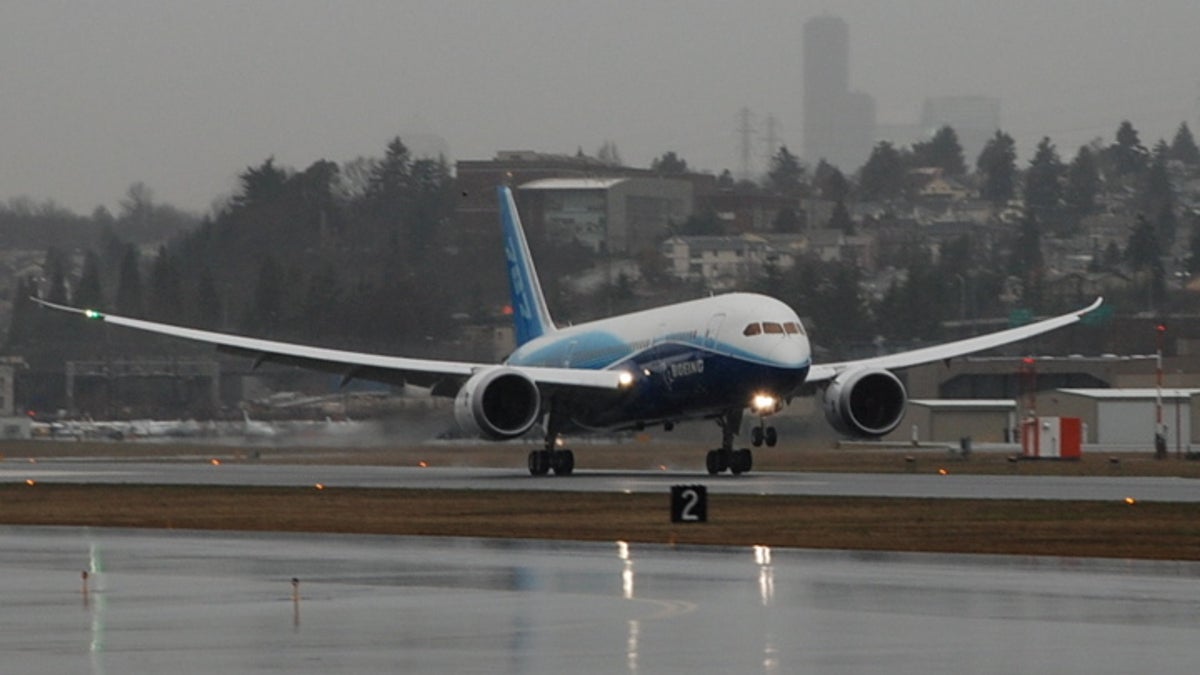Boeing's 787 completes first flight
Originally expected to be five-plus hours, the flight was shortened by bad weather. Still, Boeing calls the flight a success and says the Dreamliner performed as expected.

SEATTLE--It turns out that Boeing's 787 Dreamliner can land too.
Just three hours after taking off from Paine Field in Everett, Wash., for its first-ever flight, the 787 made a gentle landing in a pouring rain at Boeing Field here. It marked the completion of an extremely vital step for this long-delayed and keenly watched $10 billion project.
As has been well-chronicled, the 787 project has been delayed for more than two years. Boeing rolled out the plane to great fanfare on July 8, 2007--07/08/07--and promised that its first flight was just months away at that point. But structural problems, a machinists' strike, supply chain shortages and cost overruns have forced Boeing into one public delay after another.
But after the aerospace giant got the plane through an essential test last week--the so-called taxi test, in which the plane is sent rocketing down a runway at high speed in order to lift its landing gear off the ground--all systems appeared to be ready to go for the first flight.
And indeed, on Tuesday morning, at 10:28, in front of thousands of company employees and an impressive phalanx of press, the plane took off. And quickly disappeared into a very cloudy sky. That flight was originally expected to last for as much as five-and-a-half hours but was cut short by poor weather throughout the northern Washington state region.
At 1:33 p.m. Pacific time, the plane landed, just minutes after having appeared miles away in the completely overcast sky.
Befitting the public relations nature of Tuesday's developments--and the obvious opportunity for Boeing to pat itself on the back for finally crossing this important milestone--it came as no surprise when, minutes after the maiden 787 was pulled up directly in front of a giant tent where the press corps and countless Boeing employees were waiting, Scott Fancher, the 787 Dreamliner program's vice president and general manager said, "This is a day that changed the history of aviation" and that the 787 has become the "first truly all-new airplane in the 21st century."
Those statements had to do with the fact that the 787 is made from carbon fiber, becoming the first major commercial airliner to be made from composite materials.
Fancher also took the opportunity to claim that the successful flight was a "statement of our nation's competitiveness," a clear poke at Boeing's European arch-rival, Airbus.
During its three-hour-and five-minute flight, the 787 reached a height of about 15,000 feet and a top speed of 207 miles an hour. The pilots had to scuttle their original plan of flying out over eastern Washington state. Chief pilot Mike Carriker said that a scout plane had flown ahead of the 787 in order to check out the intended route but had determined the conditions there were too rough for the tests that Boeing had hoped to execute during the flight.
After the 787 was towed back in and parked in front of the tent, Carriker and co-pilot Randy Neville emerged, beaming. Carriker pumped his arms high above his head and the crowd cheered.
Back on the ground during a question-and-answer session, Carriker joked that, "I thought the landing was pretty good, I don't know about you." And Neville said that the flight had presented the two pilots with no surprises. "The airplane did exactly as we were expecting," Neville said.
Carriker explained that just the act of getting the 787 in the air had gone a long way toward answering diagnostic questions about the plane. "We figured out more things about this airplane in ten minutes of flying," he said, "than we have in probably the last 100 days."
And amplifying that point, Carriker said that once he and Neville were airborne, they had set out to execute a "very, very, very aggressive plan. In spite of the continuously descending cloud cover that forced the shortening of the flight time, they were able to complete about half of their intended tasks he said.
Still, the bad weather gave the pilots a chance to put the plane through some paces they had not intended until later in a testing program that could last as long as nine months before the planned delivery of the first 787 to All Nippon Airways in late 2010. Neville said that included flying in icy conditions and in strong turbulence.
And there were some very small victories, too.
"We even got to do a functional test of the windshield wipers," Carriker joked.
Asked when the second 787 test flight will be, Carriker said that today's plane--the first of six Dreamliners that have been built--was ready to head back up for another go. But he suggested it would be at least after the new year before the second flight.

